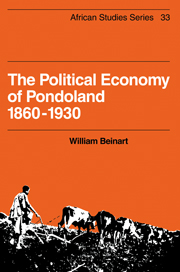Book contents
- Frontmatter
- Contents
- List of maps
- Preface
- Abbreviations
- Introduction
- 1 The political economy of Pondoland in the nineteenth century
- 2 Crops, cattle and the origins of labour migrancy, 1894–1911
- 3 Rural production and the South African state, 1911–1930
- 4 Chiefs and headmen in Pondoland, 1905–1930
- 5 Rural differentiation, alliance and conflict, 1910–1930
- Postscript
- Tables
- Notes
- Select bibliography
- Index
- BOOKS IN THIS SERIES
3 - Rural production and the South African state, 1911–1930
Published online by Cambridge University Press: 26 February 2010
- Frontmatter
- Contents
- List of maps
- Preface
- Abbreviations
- Introduction
- 1 The political economy of Pondoland in the nineteenth century
- 2 Crops, cattle and the origins of labour migrancy, 1894–1911
- 3 Rural production and the South African state, 1911–1930
- 4 Chiefs and headmen in Pondoland, 1905–1930
- 5 Rural differentiation, alliance and conflict, 1910–1930
- Postscript
- Tables
- Notes
- Select bibliography
- Index
- BOOKS IN THIS SERIES
Summary
Drought, East Coast fever and the crisis of 1912
By 1911, the year after Union, the economic position of most families in Pondoland was by no means desperate. The herds of cattle had been rebuilt, and the cattle population, at close on 280,000, was probably as high as before rinderpest (Table 5). There were more small stock in the area than ever before (Table 6). If the extension of cultivation had been constrained by lack of markets and rendered less urgent by the recovery of the herds, the homesteads still probably produced as much grain as they had immediately after the turn of the century. ‘Every kraal possesses its plough’, affirmed a magistrate in 1911–the number returned in the census of that year exceeded 14,000–and most could produce sufficient for subsistence in good and average years. Despite an apparent increase in population from under 200,000 to over 230,000 in the first decade of the century, land was not yet as short as in the rest of the Territories (Table 1). Pressure on arable plots began to show in a few locations, but in general the magistrates still thought that their districts were ‘by no means densely occupied’ nor ‘crowded’ and ‘thickly populated’. Immigrants from other Cape districts continued to find space in which to settle. Whereas roughly 9 to 10 per cent of the male population left Pondoland to work in 1911, the average for other Transkeian districts was around 18 per cent (Table 4). Yet the homesteads were now locked into the larger capitalist economy.
- Type
- Chapter
- Information
- The Political Economy of Pondoland 1860–1930 , pp. 70 - 103Publisher: Cambridge University PressPrint publication year: 1982

